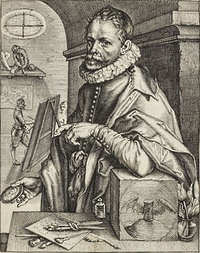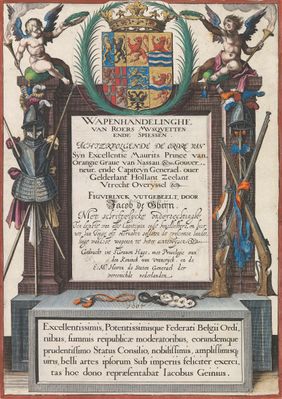|
|
You are not currently logged in. Are you accessing the unsecure (http) portal? Click here to switch to the secure portal. |
Difference between revisions of "Jacob de Gheyn II"
| Line 13: | Line 13: | ||
| occupation = {{plainlist | | occupation = {{plainlist | ||
| Painter | | Painter | ||
| − | | | + | | Engraver |
}} | }} | ||
| nationality = Dutch | | nationality = Dutch | ||
| Line 47: | Line 47: | ||
}} | }} | ||
'''Jacob de Gheyn II''' (Jacques; c. 1565 - 29 Mar 1629) was a Dutch painter and engraver, whose work shows the transition from Northern Mannerism to Dutch realism over the course of his career. De Gheyn painted some of the earliest female nudes, vanitas, and floral still lifes in Dutch art. He is credited with creating over 1,500 drawings, including landscapes and natural history illustrations. | '''Jacob de Gheyn II''' (Jacques; c. 1565 - 29 Mar 1629) was a Dutch painter and engraver, whose work shows the transition from Northern Mannerism to Dutch realism over the course of his career. De Gheyn painted some of the earliest female nudes, vanitas, and floral still lifes in Dutch art. He is credited with creating over 1,500 drawings, including landscapes and natural history illustrations. | ||
| − | |||
De Gheyn was born in Antwerp and received his first training from his father, Jacob de Gheyn I, a glass painter, engraver, and draftsman.<ref>[http://www.artnet.com/library/03/0319/T031910.asp Gheyn, de]. (2000). ''The [[Grove Dictionary of Art]].'' Retrieved January 26, 2007.</ref> In 1585, he moved to Haarlem, where he studied under Hendrik Goltzius for the next five years. He moved again, to Leiden, in the middle of the 1590s. De Gheyn married Eva Stalpaert van der Wiele of Mechelen in 1595. His son, Jacob de Gheyn III, was born in 1596, and grew to become an engraver in his own right, as well as the subject of a portrait by Rembrandt.<ref>Kren, Emil, & Marx, Daniel. [http://www.wga.hu/bio/g/gheyn/biograph.html Gheyn, Jacob de II]. (n.d.) ''Web Gallery of Art. Retrieved January 26, 2007.</ref> | De Gheyn was born in Antwerp and received his first training from his father, Jacob de Gheyn I, a glass painter, engraver, and draftsman.<ref>[http://www.artnet.com/library/03/0319/T031910.asp Gheyn, de]. (2000). ''The [[Grove Dictionary of Art]].'' Retrieved January 26, 2007.</ref> In 1585, he moved to Haarlem, where he studied under Hendrik Goltzius for the next five years. He moved again, to Leiden, in the middle of the 1590s. De Gheyn married Eva Stalpaert van der Wiele of Mechelen in 1595. His son, Jacob de Gheyn III, was born in 1596, and grew to become an engraver in his own right, as well as the subject of a portrait by Rembrandt.<ref>Kren, Emil, & Marx, Daniel. [http://www.wga.hu/bio/g/gheyn/biograph.html Gheyn, Jacob de II]. (n.d.) ''Web Gallery of Art. Retrieved January 26, 2007.</ref> | ||
Revision as of 02:13, 27 October 2018
| Jacob de Gheyn II | |
|---|---|
 "Jacobus de Geyn, Antwerp Pict. et Sculpt." by Hendrick Hondius (1610) | |
| Born | 1565 Antwerp |
| Died | 29 March 1629 The Hague |
| Spouse(s) | Eva Stalpaert van der Wiele |
| Occupation |
|
| Nationality | Dutch |
| Genres | Drill manual |
| Language | |
| Notable work(s) | Wappenhandelinghe van Roers Musquetten ende Spiessen (1607) |
| Concordance by | Michael Chidester |
Jacob de Gheyn II (Jacques; c. 1565 - 29 Mar 1629) was a Dutch painter and engraver, whose work shows the transition from Northern Mannerism to Dutch realism over the course of his career. De Gheyn painted some of the earliest female nudes, vanitas, and floral still lifes in Dutch art. He is credited with creating over 1,500 drawings, including landscapes and natural history illustrations.
De Gheyn was born in Antwerp and received his first training from his father, Jacob de Gheyn I, a glass painter, engraver, and draftsman.[1] In 1585, he moved to Haarlem, where he studied under Hendrik Goltzius for the next five years. He moved again, to Leiden, in the middle of the 1590s. De Gheyn married Eva Stalpaert van der Wiele of Mechelen in 1595. His son, Jacob de Gheyn III, was born in 1596, and grew to become an engraver in his own right, as well as the subject of a portrait by Rembrandt.[2]
De Gheyn's work attracted the attention of wealthy sponsors, and his first commission was for an engraving of the Siege of Geertruidenberg from Maurice of Nassau, Prince of Orange. This event, from 27 March to 24 June 1593, had been more of a demonstration of power by Prince Maurits, than an actual war, and had even attracted tourists. As a publicity stunt, the siege and its subsequent engraving were successful in propagating an image of Prince Maurits as an able general. Around 1600, de Gheyn abandoned engraving, and focused on painting and etching. Moving to The Hague in 1605, he was employed often by Dutch royalty, designing a garden in the Buitenhof for Prince Maurice which featured the two first grottoes in the Netherlands. After Maurice's death in 1625, de Gheyn worked for his brother, Frederick Henry.
Contents
HEMA Contributions
In 1607, de Gheyn created a series of prints illustrating militia drill with the calvera, musket, and pike. They were published in 1607-8 in the Hague, Netherlands, by Aert Meuris under the title De Nassavsche Wapen-Handelinge van Schilt, Spies, Rappier end Targe ("On the Weapon-Handling of Nassau with Shield, Spear, Rapier, and Target"); also included were anonymous descriptions and commentary in Dutch, French, and German editions.
Because an English translation has not yet been produced from one of the original languages, the text of 1625 English publication has been placed in the first transcription column. (Unfortunately, the Bodleian Library's copy, from which this transcription was made, is missing several pages.)
Images |
English Transcription (1607) |
Dutch Transcription (1607) |
French Transcription (1607) |
German Transcription (1607) | |
|---|---|---|---|---|---|
Images |
English Transcription (1607) |
Dutch Transcription (1607) |
French Transcription (1607) |
German Transcription (1607) | |
|---|---|---|---|---|---|
Images |
English Transcription (1607) |
Dutch Transcription (1607) |
French Transcription (1607) |
German Transcription (1607) | |
|---|---|---|---|---|---|
Images |
English Transcription (1607) |
Dutch Transcription (1607) |
French Transcription (1607) |
German Transcription (1607) | |
|---|---|---|---|---|---|
For further information, including transcription and translation notes, see the discussion page.
| Work | Author(s) | Source | License |
|---|---|---|---|
| Images | |||
| Dutch Transcription | Index:Wappenhandelinghe van Roers Musquetten ende Spiessen (Jacob de Gheyn II) 1607.pdf | ||
| English Transcription | Michael Chidester | Index:The Exercise of Armes For Calivres, Muskettes, and Pikes (Jacob de Gheyn II) 1607.pdf | |
| French Transcription | Index:Maniement d'Armes d'Arquebuses, Mousquetz, et Piques (Jacob de Gheyn II) 1607.pdf | ||
| German Transcription | Index:Waffenhandlung von den Rören Musquetten undt Spiessen (Jacob de Gheyn II) 1607.pdf |
Additional Resources
References
- ↑ Gheyn, de. (2000). The Grove Dictionary of Art. Retrieved January 26, 2007.
- ↑ Kren, Emil, & Marx, Daniel. Gheyn, Jacob de II. (n.d.) Web Gallery of Art. Retrieved January 26, 2007.

